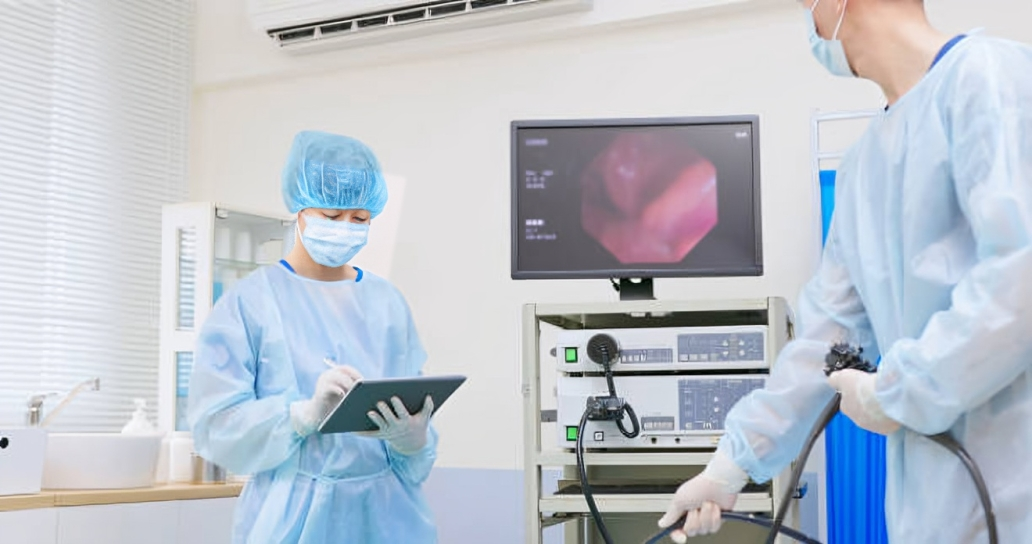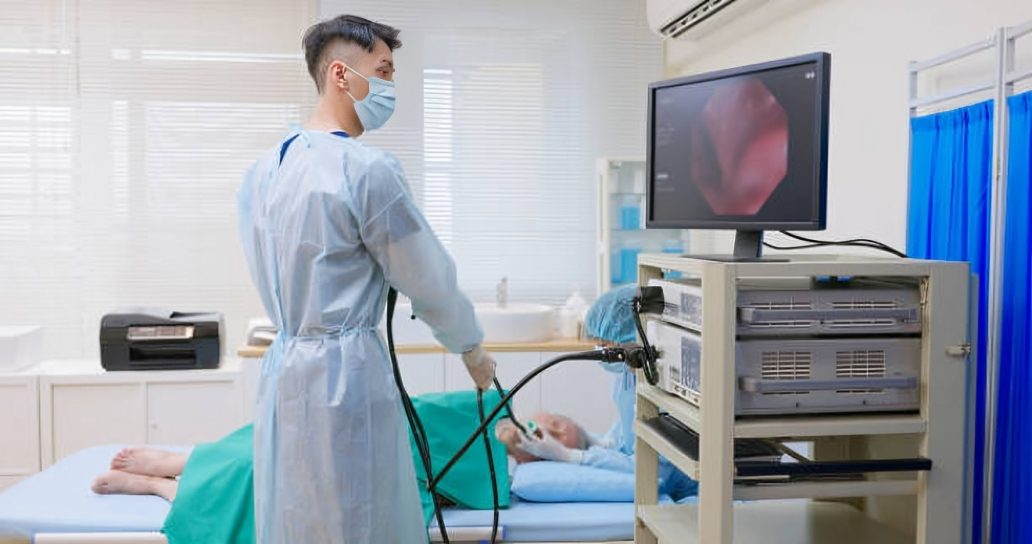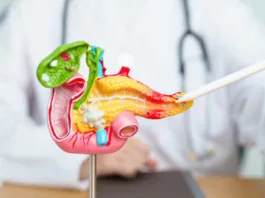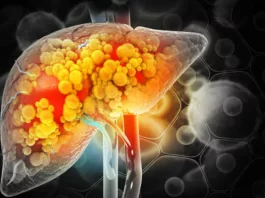What is Gastroscopy?
Gastroscopy is a diagnostic and therapeutic procedure that visualizes the upper part of the gastrointestinal tract, including the esophagus, stomach, and proximal part of the duodenum.
Nowadays, gastroscopy is the most commonly performed minimally invasive procedure for diagnosing and ruling out abnormalities in the upper gastrointestinal tract. Skilled doctors or endoscopists conduct it when examining your upper gastrointestinal tract is necessary. A flexible camera, gastroscope is inserted into your esophagus, stomach, and upper part of the intestine via the mouth. It helps visualize any discontinuity in the mucosa of your gastrointestinal tract or any GI abnormalities.
In the United States of America, this procedure is performed under the patient’s consciousness or moderate anesthesia. However, it is also being performed under topical anesthesia.1Institute for Quality and Efficiency in Health Care (IQWiG). (2015, June 30). What happens during a gastroscopy?InformedHealth.org – NCBI Bookshelf. https://www.ncbi.nlm.nih.gov/books/NBK310264/
What are the Indications of Gastroscopy?
Abnormalities of the gastrointestinal tract can not be seen with the naked eye. Therefore, this procedure makes it easy for your doctor to look into your food pipe. There are multiple indications of gastroscopy. The most common indication is the diagnosis of upper GI abnormalities. These abnormalities include the following:
Dysphagia:
Dysphagia is a painful condition in which people can not swallow liquid or solid food particles. It can be caused by neurological or mechanical abnormalities. Therefore, an upper gastrointestinal endoscopy helps your doctor visualize the problem in the food pipe that is causing dysphagia.
Peptic Ulcer Disease, Heartburn, Gastroesophageal Reflux Disease (GERD):
Peptic ulcer disease is the most common gastrointestinal abnormality. Multiple cases of peptic ulcer disease are reported at every clinical step. Gastroscopy helps to see the internal structure of your stomach to rule out the exact cause.
Upper GI Bleed:
Some bleeding disorders can cause iron deficiency anemia, making your stool appear dark or red. Gastroscopy helps your Doctor check the bleeding points. Bleeding can occur due to the following causes:
- Esophagitis (inflammation of the esophagus)
- Esophageal varices
- Portal hypertensive gastropathy
- Peptic ulcer (PUD)
- Abnormal blood vessels
Gastroscopy helps detect the cause of GI bleed.
Cancer:
This procedure also diagnoses esophageal, gastric, and intestinal carcinoma. During gastroscopy, tissue from the affected part is taken and sent to a histology lab to check its pathology, which is called a biopsy.
Therapeutic Purpose:
Gastroscopy is not only a diagnostic but also a therapeutic procedure that is used to treat several gastrointestinal abnormalities. The therapeutic uses of gastroscopy are the following:2Gastroscopy. (n.d.). Tests and Scans | Cancer Research UK. https://www.cancerresearchuk.org/about-cancer/tests-and-scans/gastroscopy
- It helps remove polyps and masses from the GI tract
- It helps facilitate the passage of food in patients who can not swallow on their own.
- Gastroscopy can be used to stop bleeding.
- It can be used to remove outgrowths.
- It is also used in patients having head and neck surgery.
What are the Contraindications of Gastroscopy?
There are some contraindications in which upper gastrointestinal endoscopy is not performed. These contraindications include:3InformedHealth.org [Internet]. Cologne, Germany: Institute for Quality and Efficiency in Health Care (IQWiG); 2006-. What happens during a gastroscopy? 2015 Jun 30 [Updated 2015 Jun 30]. Available from: https://www.ncbi.nlm.nih.gov/books/NBK310264/
- Coagulopathy (bleeding disorder)
- Severe neutropenia
- Perforation
- Abdominal aorta aneurysm
- Unconscious patient unless he is not incubated
- Recent history of ischemic heart disease
- Patient not tolerating anesthesia
- Unwilling patient
How can you prepare for the Gastroscopy?
Hospitals offer endoscopy units where medical professionals perform this procedure. Your doctor will prepare you before the procedure.
History & Examination:
Before the procedure, your doctor will examine and briefly review your medical history to assess your suitability for surgery.
Inform your doctor of cardiac or pulmonary illnesses that can affect this procedure. Moreover, tell your doctor if you are allergic to any drug or have recent abdominal surgery
After taking history and doing a physical examination, your doctor will advise you on some investigations, like:
- Complete blood count (CBC)
- Coagulation profile
- Complete urine examination
- ECG to check any cardiac illness
- Chest X-ray to check any pulmonary abnormality
Informed Consent:
Doctors educate patients about the procedure’s indications, benefits, and complications. After providing all the information, your doctor will ask you to sign the consent form to allow him to perform a gastroscopy. A witness signature will also be required for this purpose.
Procedure for a Gastroscopy
You will be prepared for the procedure on the day of the gastroscopy. Your doctor will advise you not to eat food or drink liquids 4 to 6 hours before the procedure to ensure your stomach is empty. It is the most critical step to prevent spillage of your stomach or abdominal contents into the windpipe (respiratory tract). Preparation of the Patient includes:
Preparation
After labs and other investigations, you will be prepared for the procedure. During preparation, your doctor will send you to the endoscopic unit, where you will wear a sterile dressing. After that, the doctor will give you an anesthesia protocol.
Anesthesia:
In the United States of America, doctors perform gastroscopy, or EGD, while the patient is conscious, typically using topical anesthesia. This choice is favored for its minimal post-anesthesia side effects, cost-effectiveness, and quicker recovery. Topical anesthesia includes cetacaine and lidocaine. During conscious sedation, the doctors monitor the patients regularly.
However, it can also be performed under moderate anesthesia. The sedative agents that are used in moderate anesthesia include:
- Benzodiazepines
- Opioids
- Reversal agents (naloxone and flumazenil)
Positioning of the Patient:
After the topical or moderate anesthesia, the patient will lie in the left lateral position.

Antibiotic Prophylaxis:
Bacteremia can occur during the procedure. Therefore, giving a prophylactic dose of antibiotics is necessary to reduce the risk of getting an infection like pneumonia.
Procedure:
During the procedure, you will lie in the left lateral position, and your doctor will administer topical or moderator sedative anesthesia to minimize the gag reflex that may affect the endoscopic procedure.
Peristalsis can also affect the procedure. Therefore, it is important to administer antispasmodic agents to stop peristaltic activity. The antispasmodic agents include:
- Hyoscine
- Atropine
- Glucagon
- Butyl bromide
A bite lock can prevent tooth damage caused by the endoscope and make it easy to pass through the mouth.
Finally, under direct vision through the camera, the doctor will insert an endoscope into your mouth down to your pharynx, esophagus, stomach, and proximal part of your intestine (duodenum). It is critical to administer an endoscope carefully to avoid damage to the surrounding structure. This procedure takes about 10-15 minutes to complete.

Afterward, the doctor will take pictures or videos of the internal GI tract and document them with relative findings. If needed, he can also take a biopsy of the tissue or mucosa through an endoscope by administration of small forceps to take tissue samples.4Yusuf, T. E., MD. (n.d.). Esophagogastroduodenoscopy (EGD) technique: upper gastrointestinal endoscopy, complications. https://emedicine.medscape.com/article/1851864-technique?scode=msp&st=fpf&socialSite=google&icd=login_success_gg_match_fpf&form=fpf
Risks & Complications of Gastroscopy
Generally, gastroscopy is a safe procedure and is done without any problems. Some people develop sore throats after this procedure that settle down on their own within 2-3 days. Some people feel sleepy after the procedure due to the after-anesthesia effect. However, it can cause complications in some cases. These include:
- Accidental damage to surrounding vessels of the esophagus and stomach causes bleeding
- Pain during swallowing
- Breathing problems
- Pain in stomach, throat, and neck
- Fever
- Nausea and vomiting
- Stroke can also occur in older individuals, but in rare cases.5Khan, R., & Grover, S. C. (2020). A standardized technique for gastroscopy: Still missing?. Endoscopy international open, 8(10), E1231–E1232. https://doi.org/10.1055/a-1216-1933
When To See Your Doctor After Gastroscopy?
Gastroscopy is a safe procedure. However, if you are experiencing the following symptoms after the gastroscopy, immediately book your appointment with your physician. These symptoms include:
- Severe abdominal pain
- Abdominal tenderness and swelling
- Vomitus containing blood
- High-grade fever
- Breathing problem
Gastroscopy vs. Endoscopy
Gastroscopy is a type of endoscopy. It is a limited and non-invasive procedure in which your doctor inserts the endoscope through the mouth up to the duodenum.
Endoscopy is a procedure that helps your doctor visualize your internal organs. Depending on the type and location, endoscopy can be invasive or non-invasive. It can be done on multiple body organs, including the lungs, uterus, joints, bladder, abdominal viscera, and larynx.6Gastroscopy vs Endoscopy | Gleneagles Hospitals. (n.d.). Gleneagles. https://gleneagles.com.my/medical-specialties/gastroenterology/gastroscopy-endoscopy
Gastroscopy vs. Colonoscopy
Gastroscopy is a procedure to visualize the upper portion of the gastrointestinal tract until the duodenum. It is both a diagnostic and therapeutic procedure. However, it can not visualize the rectum and small intestine.
If the problem is in your large intestine or rectum, your doctor will advise you to have a colonoscopy. In this procedure, the doctor will insert a colonoscope into the body through the anal opening to visualize the rectum and large intestine. A colonoscopy is preferable when you have blood in your stools, complaints of change in bowel habits, inflammatory bowel disease (ulcerative colitis and Crohn’s disease), diverticulitis, polyps, and carcinoma (rectal or intestinal).7Stauffer CM, Pfeifer C. Colonoscopy. [Updated 2023 Jul 24]. In: StatPearls [Internet]. Treasure Island (FL): StatPearls Publishing; 2024 Jan-. Available from: https://www.ncbi.nlm.nih.gov/books/NBK559274
When will I recover after the Gastroscopy?
Gastroscopy is a small and safe procedure that takes 10-15 minutes. You will recover within half an hour after the procedure. However, in case of sedation, recovery can be delayed by 1-2 hours.
Is Gastroscopy a painful procedure?
No, gastroscopy is not painful because local or moderate anesthesia is given to numb your throat. However, it can cause discomfort or gagging during the insertion of an endoscope.
Can I drive home after the Gastroscopy?
No, you can not drive home after the gastroscopy because the effect of anesthesia given before the procedure can last for 1-2 hours or more and make you feel drowsy. Therefore, it’s better to accompany someone who will take you home safely.
Can Gastroscopy Detect Cancer?
Gastroscopy not only visualizes the upper gastrointestinal tract but also enables tissue biopsies if cancer is suspected. Your doctor will use forceps to obtain a tissue biopsy of the suspected area. After taking the biopsy, your doctor will send it to the pathologist, who will diagnose the cancer. However, we can say that gastroscopy can detect cancer. It is one of the earliest tests for cancer diagnosis.
Can I eat food or drink after the Gastroscopy?
No, you can not eat or drink on your own after the procedure. You have to wait until the anesthesia effect wears off. Your doctor will instruct you when to resume your diet.8Basu, S. (2023, October 27). Gastroscopy: Procedure, risks, and results. Netmeds. https://m.netmeds.com/health-library/post/gastroscopy-procedure-risks-and-results
Conclusion
To conclude, gastroscopy is a minimally invasive procedure to visualize your upper gastrointestinal tract. Indications of gastroscopy are upper Gl bleed, dysphagia, and obtaining a biopsy for carcinomas. Therapeutic uses include removing polyps, stopping upper GI bleed, and head and neck surgeries. The downtime for gastroscopy is half an hour. However, the effect of anesthesia can last for a few hours.
Refrences
- 1Institute for Quality and Efficiency in Health Care (IQWiG). (2015, June 30). What happens during a gastroscopy?InformedHealth.org – NCBI Bookshelf. https://www.ncbi.nlm.nih.gov/books/NBK310264/
- 2Gastroscopy. (n.d.). Tests and Scans | Cancer Research UK. https://www.cancerresearchuk.org/about-cancer/tests-and-scans/gastroscopy
- 3InformedHealth.org [Internet]. Cologne, Germany: Institute for Quality and Efficiency in Health Care (IQWiG); 2006-. What happens during a gastroscopy? 2015 Jun 30 [Updated 2015 Jun 30]. Available from: https://www.ncbi.nlm.nih.gov/books/NBK310264/
- 4Yusuf, T. E., MD. (n.d.). Esophagogastroduodenoscopy (EGD) technique: upper gastrointestinal endoscopy, complications. https://emedicine.medscape.com/article/1851864-technique?scode=msp&st=fpf&socialSite=google&icd=login_success_gg_match_fpf&form=fpf
- 5Khan, R., & Grover, S. C. (2020). A standardized technique for gastroscopy: Still missing?. Endoscopy international open, 8(10), E1231–E1232. https://doi.org/10.1055/a-1216-1933
- 6Gastroscopy vs Endoscopy | Gleneagles Hospitals. (n.d.). Gleneagles. https://gleneagles.com.my/medical-specialties/gastroenterology/gastroscopy-endoscopy
- 7Stauffer CM, Pfeifer C. Colonoscopy. [Updated 2023 Jul 24]. In: StatPearls [Internet]. Treasure Island (FL): StatPearls Publishing; 2024 Jan-. Available from: https://www.ncbi.nlm.nih.gov/books/NBK559274
- 8Basu, S. (2023, October 27). Gastroscopy: Procedure, risks, and results. Netmeds. https://m.netmeds.com/health-library/post/gastroscopy-procedure-risks-and-results





